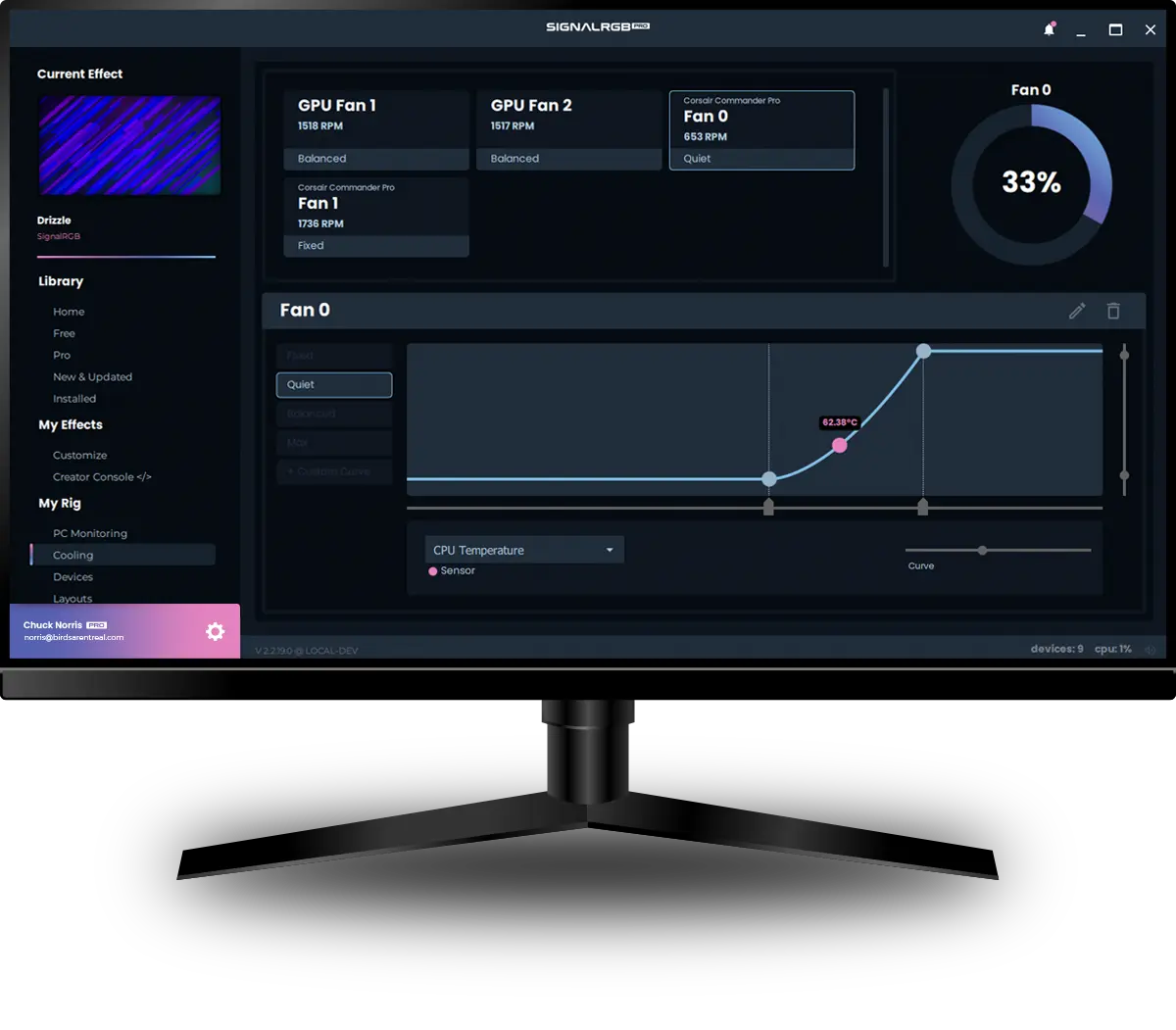
Get more with
SIGNAL RGB pro

Game Integrations
Experience dynamic RGB effects that respond to top gaming titles. Enjoy new game integrations added every month.

Macros
With Signal RGB macros, you can customize your gaming experience by automating various functions, like triggering specific effects when launching a game.

PC Monitoring & Fan Control
Optimize your system performance by managing your setup and setting custom fan curves to keep your rig cool.

Audio Visualizers
Transform your RGB setup into a synchronized light show that works with any audio source from your computer.
User Setups
Signal RGB lets you control your RGB devices your way. Need some inspiration?
Check out user-submitted setups for creative ideas.
Signal RGB is a powerful software solution that simplifies and enhances the RGB lighting experience. Its primary goal is to provide users with a unified platform to control and synchronize the RGB lighting of all their hardware components and peripherals, regardless of the brand. This means that whether you have an RGB keyboard from one manufacturer, a graphics card from another, and RAM from another, you can control all their lighting effects from one place.
Signal RGB’s broad compatibility is a standout feature, ensuring that users can integrate nearly all their RGB components into one cohesive lighting system. This eliminates the need for multiple proprietary software applications, each with its own interface and limitations, making Signal RGB a user-friendly choice.
Signal RGB also offers robust customization options, allowing users to create and apply lighting effects. Whether you want a subtle, professional look for your work environment or a dynamic, colorful display for gaming sessions, Signal RGB provides the tools to achieve your desired effects. Users can sync these effects across all their devices, creating a harmonious and visually stunning setup.
Key Features of Signal RGB
Signal RGB offers a range of powerful features designed to enhance and synchronize RGB lighting across various PC components and peripherals. Here are the key features that make Signal RGB stand out:
1. Multi-Device Synchronization
Signal RGB allows users to seamlessly synchronize RGB lighting across multiple devices. This includes compatibility with motherboards, graphics cards, RAM modules, fans, and peripherals from different manufacturers. By unifying RGB control, Signal RGB ensures a consistent and synchronized lighting experience throughout your entire setup.
2. Custom Lighting Effects
Signal RGB’s intuitive interface allows users to create and customize a wide variety of RGB lighting effects. Whether you prefer static colors, dynamic patterns, pulsating effects, or complex animations, Signal RGB provides extensive customization options. This flexibility allows users to tailor their RGB lighting to match personal preferences or to complement specific themes in their setups.
3. Game Integrations
Signa lRGB enhances gaming experiences by integrating popular games to synchronize RGB lighting with in-game events. This feature allows RGB lighting to react dynamically to gameplay actions such as health status changes, critical hits, or environmental cues. By immersing players in synchronized lighting effects, Signal RGB enhances the overall gaming ambiance and can provide visual cues during intense gaming sessions.
4. Music Synchronization
Users can synchronize RGB lighting with music using Signal RGB, creating a dynamic audio-visual experience. The software analyzes the audio output in real time, translating music beats and rhythms into corresponding RGB lighting effects. Whether gaming, hosting a party, or simply enjoying music, Signal RGB transforms your PC into a synchronized light show that responds to the music’s tempo and mood.
5. Cloud Profiles
Signal RGB supports cloud profiles, allowing users to save, share, and download lighting profiles from a community-driven platform. This feature enables users to explore and use custom lighting setups created by other enthusiasts, fostering creativity and community engagement. It also simplifies finding and applying new lighting configurations without requiring extensive manual customization.
6. User-Friendly Interface
Signal RGB features an intuitive user interface that makes it easy for beginners and advanced users to navigate and customize RGB lighting settings. The interface provides straightforward controls for creating, editing, and applying lighting profiles, ensuring a hassle-free experience managing RGB lighting across your PC setup.
7. Advanced Control Options
For users seeking more detailed customization, Signal RGB offers advanced control options. This includes fine-tuning individual lighting zones, adjusting brightness levels, and applying specific effects to different components independently. These advanced controls empower users to achieve precise and tailored RGB lighting effects that suit their unique preferences and setups.
Installation and Setup
System Requirements
Before installing Signal RGB, ensure that your system meets the minimum requirements:
- Operating System: Windows 10 or later
- Processor: Intel Core i5 or equivalent
- RAM: 8GB or more
- Graphics: DirectX 11 compatible GPU
- Storage: 500MB of available space
- Internet Connection: Required for downloading the software and updates
Step-by-Step Installation Guide
- Download Signal RGB:
- Visit the official Signal RGB website.
- Navigate to the download section and click the download button.
- Save the installer file to your preferred location.
- Run the Installer:
- Locate the downloaded installer file and double-click to run it.
- If prompted by User Account Control (UAC), click “Yes” to allow the installer to change your device.
- Install Signal RGB:
- Follow the on-screen instructions in the installation wizard.
- Choose the installation directory or proceed with the default location.
- Agree to the terms and conditions and click “Install.”
- Wait for the installation to complete. This may take a few minutes.
- Launch Signal RGB:
- Once the installation is complete, you can launch Signal RGB immediately by selecting the checkbox and clicking “Finish.”
- Alternatively, you can find the Signal RGB shortcut on your desktop or in the Start menu to open the application later.
Initial Setup and Configuration
- First-Time Setup:
- Upon launching Signal RGB for the first time, you may be prompted to create an account or log in.
- Follow the instructions to set up your account. This may involve providing an email address and creating a password.
- Detecting Devices:
- Signal RGB will automatically scan your system for compatible RGB devices.
- Ensure all your RGB hardware is connected and properly installed.
- The software will display a list of detected devices. Verify that all your devices are listed.
- Configuring Devices:
- Click on each device to configure its settings.
- You can customize each device’s lighting effects, brightness, and other parameters.
- Explore the various available presets and effects, or create custom effects.
- Syncing Devices:
- To synchronize lighting effects across multiple devices, go to the sync settings.
- Select the devices you want to synchronize and choose a sync mode (e.g., static, breathing, wave).
- Apply the settings to see the changes in real time.
- Saving Profiles:
- After configuring your devices, you can save your settings as a profile.
- Go to the profiles section, click “Create New Profile,” and give it a name.
- Save the profile; you can easily switch between different profiles as needed.
- Exploring Advanced Features:
- Signal RGB offers advanced features such as game integration, automation, and scripting.
- Explore the settings and options to tailor the software to your needs and preferences.
Troubleshooting
- Device Not Detected: Ensure your device is connected correctly and the latest drivers are installed.
- Software Issues: If Signal RGB crashes or fails to start, try reinstalling the software or checking for updates.
- Support: Visit the Signal RGB support page or forums for additional help and resources.
With Signal RGB installed and configured, you can enjoy a seamless and customizable RGB lighting experience across all your compatible devices.
Tips and Tricks for Using Signal RGB
To make the most out of Signal RGB and optimize your RGB lighting experience, consider these tips and tricks:
Update Regularly
Stay Current: Keep Signal RGB updated to access new features, performance improvements, and compatibility fixes. Regular updates often introduce new lighting effects and enhance overall stability.
Plan Your Lighting Setup
Theme and Harmony: Before customization, plan how you want your RGB lighting to complement your PC setup. Consider color schemes, effects coherence, and how lighting will enhance your workspace or gaming environment.
Utilize Profiles and Presets
Save Time: Experiment with built-in presets or download community-created profiles to quickly achieve impressive lighting effects. Customize these presets to match your preferences rather than starting from scratch.
Sync with Games and Music
Enhanced Experience: Use Signal RGB’s game integration to synchronize lighting effects with gameplay events. Similarly, use music synchronization for dynamic lighting that responds to the rhythm and beat of your favorite tunes.
Optimize Performance
Resource Management: Adjust settings within Signal RGB to optimize performance. Some effects can be more resource-intensive than others, so find a balance that enhances visuals without impacting system performance.
Explore Advanced Settings
Fine-tuning: Dive into advanced settings to fine-tune lighting effects further. Adjust parameters such as speed, intensity, and color gradients to precisely achieve the desired effect.
Community Engagement
Share and Learn: Join Signal RGB communities online to share your setups, gain inspiration from others, and discover new techniques for RGB customization. Participating in these communities can also provide troubleshooting tips and creative ideas.
Back-Up Your Profiles
Protect Your Work: Regularly back up your customized profiles and settings. This ensures that you can quickly restore your preferred lighting configurations if you need to reinstall Signal RGB or switch to a new PC.
Experiment and Have Fun
Creative Freedom: Feel free to experiment with different lighting effects and combinations. RGB lighting is an innovative tool, so enjoy discovering new ways to personalize your setup and make it uniquely yours.
Frequently Asked Questions (FAQs)
Signal RGB is a software application used for controlling and synchronizing RGB lighting across PC components and peripherals.
Signal RGB supports compatibility with a variety of devices including motherboards, graphics cards, RAM modules, fans, and peripherals that feature RGB lighting.
Signal RGB can typically be downloaded from its official website or other authorized software distribution platforms.
Signal RGB may offer both free and paid versions, depending on the features and functionalities you require.
Yes, Signal RGB allows users to synchronize RGB lighting across different brands and types of RGB-compatible devices.
Yes, Signal RGB enables users to create and customize a wide range of RGB lighting effects using an intuitive interface.
Yes, Signal RGB supports game integrations that synchronize RGB lighting with in-game events and actions.
Signal RGB analyzes audio output in real-time to synchronize RGB lighting effects with the beat and rhythm of music.
Yes, Signal RGB allows users to save their customized lighting profiles and share them with others via cloud-based storage.
Signal RGB is primarily compatible with Windows operating systems, typically Windows 10 and above.
Signal RGB is primarily designed for desktop use and does not typically have a mobile app version.
After installation, launch Signal RGB, connect compatible devices, and begin customizing lighting effects through the intuitive interface.
Yes, Signal RGB can run in the background to maintain synchronized RGB lighting effects while you use your computer.
Signal RGB’s resource usage can vary depending on the complexity of lighting effects and number of synchronized devices, but it generally aims to be efficient.
Updates for Signal RGB are typically released periodically to introduce new features, improvements, and bug fixes.
Signal RGB supports a wide range of RGB peripherals, but compatibility may vary based on manufacturers and specific models.
Signal RGB primarily focuses on desktop PCs and may not offer extensive support for controlling RGB lighting on laptops.
Signal RGB is designed for PC components and peripherals with RGB lighting capabilities and may not support non-PC devices.
Signal RGB features an intuitive user interface that is designed to be accessible for users new to RGB lighting customization.
Signal RGB is typically designed for synchronizing RGB lighting within a single PC setup or room and may not support multi-room synchronization.
Signal RGB can be utilized in professional settings such as studios or events to enhance visual effects and ambiance with customizable RGB lighting.
Signal RGB may offer technical support through its official website, forums, or community channels.
Signal RGB’s compatibility with third-party software and hardware may vary and typically depends on specific integrations and APIs.
Signal RGB’s cloud profile storage typically ensures secure storage of user profiles, but users should follow best practices for account security.
Signal RGB is designed to control RGB lighting effects and typically does not include specific features for preventing hardware damage.
Signal RGB’s control capabilities may extend to RGB strips and external lighting accessories, depending on their compatibility with RGB control software.
Signal RGB’s functionality generally focuses on local RGB lighting control and synchronization and may not include direct integration with social media or streaming platforms.
Signal RGB may be compatible with VR setups for enhancing RGB lighting effects within a VR environment, depending on hardware compatibility.
Signal RGB can serve educational purposes for learning about RGB lighting customization, effects creation, and synchronization techniques.
Users can contribute to Signal RGB’s community by sharing customized profiles, participating in forums, providing feedback, and suggesting feature improvements through official channels.
Signal RGB - Custom RGB Lighting Solutions for Gaming & PCs

Signal RGB for the best RGB lighting solutions! Explore LED strips, keyboards, and more for stunning gaming setups and PC customization. #SignalRGB
Price: Free
Price Currency: $
Operating System: Window 7,8,10 and 11
Application Category: Software
4.7
